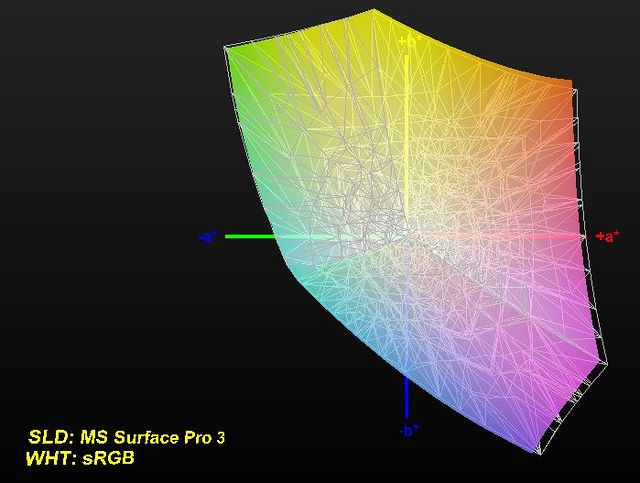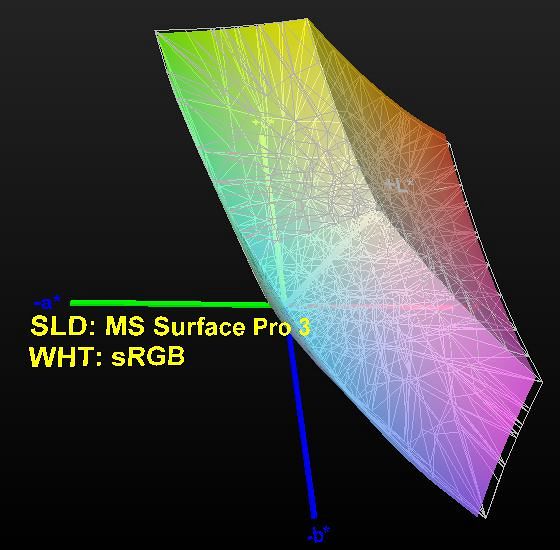Monitor gamuts. The good, the bad, and the ugly.
I was curious how the various "sRGB" gamut monitors I use actually fit into the sRGB color space. So I measured them. Sometimes the truth isn't pretty.
- Desktop Monitors
- NEC PA241W
- Viewing 3D VRML models
- HP LP2065
- Samsung SyncMaster 2333HD
- Acer S2020HL
- Envision EN5400e
- Laptop Monitors
- Lenovo IBM T60 Thinkpad laptop
- Microsoft Surface Pro 3
- Macbook Pro 1,1
- Macbook Pro 6,2
- Puget Systems B560i laptop
- HP Pavilion dm3 laptop
- Toshiba laptop
- Acer Aspire One Netbook
- Acer Big Netbook
- Conclusion
Desktop Monitors
NEC PA241W
This is the best one. This one is really good.
NEC PA241W in sRGB emulation mode
First we'll start off with my NEC PA241W monitor. This is high endish in that the calibration software and hardware communicates with hardware that is inside the monitor to make the monitor itself conform to the target of the desired calibration. (As far as can be achieved with the monitor's phospors.) Because this is a "wide gamut" monitor, the monitor can easily achieve sRGB. So it is sRGB. The solid color shape is the gamut of the monitor. The white wireframe is sRGB. They match up almost exactly. PA241W: 830,081 cubic colorspace units. sRGB: 833,600 cubic colorspace units
Here is the link to the 3-D version
Viewing 3D VRML models
The important points is that, because the monitor itself conforms to sRGB, that sRGB images look identical when viewed inside of a color managed application and when viewed outside of a color managed application. This is a Big Deal with using Windows, because most programs aren't color managed.
The PA241W is my only monitor that has this internal circuitry that make the monitor conform to the desired target. All the rest of the monitors only can display whatever their native gamut is (when not viewed using a color managed program.) Their native gamut generally isn't exactly the same as sRGB. And is sometimes very different than sRGB (hence, the title of this page.)
HP LP2065
Here is my next best monitor. It is also good.
HP LP2065. Is about the same size as sRGB.
This is an IPS monitor and it almost fits sRGB (but not exactly.) So this monitor isn't too bad for editing images. Here is the link to the 3-D version. HP LP2065: 868,592 cubic colorspace units. sRGB: 833,600 cubic colorspace units
Samsung SyncMaster 2333HD
Still good.
Samsung SyncMaster 2333HD. Is about the same size as sRGB.
This is a 23" TN monitor that is half decent (for a TN monitor) in that it cost about $300. This is the monitor I (used to) use for my secondary monitor. After calibrating with an XRite i1 Display Pro and iProfilier it only looks a little different than my PA241W. When looking at sRGB images. Here is the link to the 3-D version. If you rotate the 3D version around, you'll see that the bottom part of the spectrum is larger than sRGB. And you can see from the top of the 2D image that red-orange extends beyondsRGB. Which makes for a slight, but noticible difference when viewing images inside and outside of color managed programs. SyncMaster 2333HD: 895,218 cubic colorspace units. sRGB: 833,600 cubic colorspace units
Acer S2020HL
Starting to get ugly.
Acer S2020HL. Not fitting sRGB.
Acer S2020HL. Look at the bottom.
This is a cheap ($120) TN monitor I got when I wanted to run four monitors at once. The criterea were "light" and "cheap." Image quality wasn't high on the list. You can see that its gamut doesn't even fill sRGB. Even worse, in other places it extends beyond sRGB. Ahh, viewing images of any kind on this monitor isn't very pleasant. Because the S2020HL's gamut is considerably smaller than sRGB, viewing in color managed programs doesn't help much. A color managed program will get rid of the portion of the gamut that extends beyond sRGB, but can't do anything to add to the portion of the monitor gamut that doesn't fill sRGB. Acer S202HL: 788,409 cubic colorspace units. sRGB: 833,600 cubic colorspace units
Here is the link to the 3-D version If you rotate the 3-D version around, you will probably get an O. M. G. reaction when you think of a poor color managed program grunting and groaning trying to make the monitor fill sRGB. But wait, I've got more in my monitor gallery of horrors.
Envision EN5400e
Not quite good. But not very bad.
Envision EN5400e. A bit smaller than sRGB
Envision EN5400e. A bit smaller than sRGB
This is a very cheap 15 (or so) inch monitor that my nephew found in a box at the side of the road. We were very surprised that it worked at all. But the face of the monitor was pock-marked like it had been in the same room as an arc welder. And the screen was showing its age. But it did display an image so I decided to measure it to add to my collection of gamut plots.
Here is the link to the 3-D version Actually, not bad and is reasonably symetrical. A bit shy for a desktop but this would be a king among laptop monitors. Sigh. See below. EN5400e: 700,285 cubic colorspace units. sRGB: 833,600 cubic colorspace units
Laptop Monitors
Lenovo IBM T60 Thinkpad laptop
Not very good. But not ugly.
Lenovo IBM T60 Thinkpad. A bit small.
Lenovo IBM T60 Thinkpad. A bit small.
Now we come to my Lenovo IBM T60 Thinkpad (Yes, it says Lenovo IBM Thinkpad. This was right after IBM sold their laptop division to Lenovo. The "IBM" part is molded in the plastic. "Lenovo" is painted.) I have measured this screen numerous times, with several different calibrators and the size of the gamut never changes. Yes, it is this small. But it is pleasant to look at because the gamut is symetrical. And the viewing angles are pretty good for a TN panel. So I suspect that this isn't a cheap TN panel, but was chosen for comfortable viewing when used for many hours a day. Which is nothing to sneeze at.
Here is the link to the 3-D version Rotating it around doesn't make the T60 gamut any bigger. T60: 453,329 cubic colorspace units sRGB: 833,600 cubic colorspace units. Oh, my.
Microsoft Surface Pro 3

Microsoft Surface Pro 3 Maybe?

Microsoft Surface Pro 3
This is my new Microsoft Surface Pro 3. I like it a lot. It doesn't look exactly like my NEC PA241W, but I'm told that getting two dissimilar monitors to match is impossible. Just use proper color management techniques (printer profiles, soft proofing, etc.) and it should be fine. It runs CC Photoshop very well.
Here is the link to the 3-D version of the gamut plot.
Macbook Pro 1,1
Umm.
Macbook Pro1,1
Macbook Pro1,1
From 2006. With a degraded backlight. This gamut is a warning against using old technology for doing anything color critical.
3D view Macbook6,1: 386,187 cubic colorspace units. sRGB: 833,600 cubic colorspace units.
Macbook Pro 6,2
Pretty good
Macbook Pro 6,2 Mid 2010
Macbook Pro 6,2 Mid 2010
A Macbook Pro 6,2 that belonged to a friend of mine. The gamut looks pretty good. It fills sRGB, and then some.
3D view Macbook: 990,589 cubic colorspace units. sRGB: 833,600 cubic colorspace units.
Puget Systems B560i laptop
Almost good. For a TN monitor.
Puget B560i Glossy TN top.
Puget B560i Glossy TN side.
This is the 1920x1080 glossy screen option for the Puget Systems B560i 15 inch notebook. The gamut is bigger but still doesn't fill sRGB. 602,393 cubic colorspace units. sRGB: 833,600 cubic colorspace units.
HP Pavilion dm3 laptop
Not good. But not ugly.
HP Pavilion dm3 laptop. A bit small.
HP Pavilion dm3 laptop. A bit small.
A garden variety consumer level HP dm3 laptop. It isn't quite as pleasant to look at as my T60, but it also cost a whole lot less. Shrug. It works for looking at Facebook.
Here is the link to the 3-D version If you compare the bottom of the gamut with the T60's gamut, you'll see that the dm3 doesn't go down as far on the bottom as the T60 does. This may be part of the reason why the T60 monitor looks better than the dm3's does. HP dm3: 477,455 cubic colorspace units. sRGB: 833,600 cubic colorspace units.
Toshiba laptop
Ugly
Toshiba laptop. A bit small.
Toshiba laptop. A bit small.
Toshiba Satellite T135D - S1324. It is was bought around the same time as the HP dm3 and cost about the same. (2018--it still works.)
The 3-D version This one is really bad at displaying pictures. Not only is the gamut small and a bit more asymetrical but the dynamic range is limited so it blows highlights a lot. And the viewing angle seems especially small. Even for a laptop. Toshiba: 476,732 cubic colorspace units. sRGB: 833,600 cubic colorspace units.
Acer Aspire One Netbook
Bad. And a bit ugly.
Acer Aspire One netbook. A bit small.
Acer Aspire One netbook. A bit small.
This is one of the classic netbooks that everybody loves to hate. Small screen, 1 GB of (non-expandable) RAM, etc., etc. But I sort of liked it as a travel computer to back up digipics while on the road. Even if it is cramped.
The 3-D version. Not much good for image editing though. The gamut is too small and is asymetrical compared to sRGB. But is a lot better than nothing to examine images on the road. Acer 8" netbook: 493,989 cubic colorspace units. sRGB: 833,600 cubic colorspace units.
Acer Big Netbook
Not good. But not ugly.
Acer big netbook. A bit small.
Acer big netbook. A bit small.
I like this one. It is a larger netbook. 11" screen, but has the standard 1366x768 resolution that most other laptops have; 4 gig of RAM and a dual core processor that is only a little slower than regular $500ish laptops (of the era.) This cost $300 and is a very good travel laptop. It is only a little larger than a classic netbook, but isn't cramped at all--it acts like a laptop. For the price, it is really neat. And, um, there is nothing on the market right now that is comparable. The computer industry doesn't seem to like to sell $300 laptops that are really useful.
The 3-D version Again, not much good for image editing though. The gamut is too small. But it is more symetrical than the smaller netbook. Acer 11" netbook: 489,601 cubic colorspace units. sRGB: 833,600 cubic colorspace units.
Conclusion
The more that the native gamut (the solid color in all the above plots) of a non-wide gamut monitor diverges from sRGB (the white wireframe), the less the monitor is suited for editing images. Especially if the native gamut is appreciably smaller than sRGB. The top three desktop monitors aren't too bad but because they are different than sRGB in some areas (except for the NEC PA241W), images look different when viewed inside and outside of color managed programs.
The laptops.... Sigh. Not only are most of their gamuts considerably smaller than sRGB (except for the Macbook), but some are asymetrically different in shape. Try not to look at images very hard on laptops that have gamuts that are like this.
When people on photo forums discuss laptops, usually the only thing they discuss is viewing angles. The above gamut plots should demonstrate that the concerns for laptops monitors don't end with viewing angles. If you will be editing images.
All gamut plots were taken from my collection of 3D color spaces.
Questions? Write to monitorgamuts@frogymandias.org